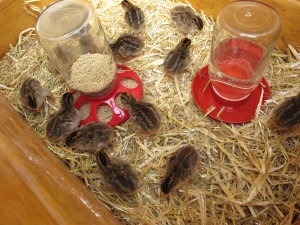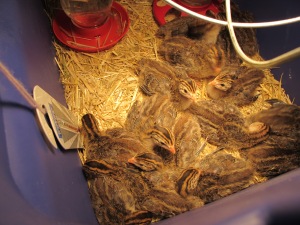This post contains affiliate links to Amazon.com. If you make a purchase by clicking on my links, I do receive a small commission.
As soon as the weather warmed up for our first spring here at Red Tree Ranch, we quickly realized we had a problem. A big problem. An infestation. Apparently our property was “Tick-tropolis,” as my Lion Cub told me.
While we’ve been using some UN-natural insect and tick repellent (I bought a 12-pack of this), we are also doing some things to reduce the tick population naturally. One tick-reducing measure is doing some weed-wacking near the house and frequently-used paths. We have also been putting food grade diatomaceous earth
in places like under the dog house (safe for people and pets, but kills all sorts of creepy-crawlies, not just ticks).
Something with long-term payoff is introducing these little guys to our land:
They are even bigger now, but I didn’t take a pic today. We got them 10 days ago and I think they may have tripled in size! Baby guineas are called keets, and they make some interesting chirps. Sometimes they sound like crickets, frogs, or aliens (because I know what aliens sound like, right?). We have tried handling them frequently so they will be tame, but it doesn’t seem to be working. As time goes on, they seem to trust us less. This wary nature could be a benefit, as they are supposed to make excellent “watch-birds” and will raise a ruckus when new people or creatures find their way onto our property. I even read about a flock of guineas chasing off a coyote! As long as I can convince them to return to their roost every night to lock them up, they should be a great benefit to our homestead. While turkeys and chickens are supposed to be good at eating ticks, guineas are reputed to be the best for tick control. We shall see!
We have 15 of them. My only prior experience with raising poultry was with turkeys one year at summer camp. We started with 12 or 15, and if I recall correctly, only about 5 or 6 made it to adulthood. I knew I could do better than that, but I was expecting at least a couple losses. Yet so far, all my guineas look healthy and strong. They truly are strange creatures though. Yesterday I tried to put a paper towel under their feeder so that when they spill their feed, they might be able to see it better on the floor. However, they spent about 10 or 15 minutes huddled at one end of the cage, cheeping fearfully and staring at the white paper towel of doom. I gave up and took the towel out, afraid it was going to stress them too much.
Anyways, aside from eating ticks, the guineas will also provide us with meat, eggs, and possibly even a little income should we choose to choose to sell or barter any of the above OR some of their babies. Heck, if we have a need for tick-eating birds, I imagine we aren’t the only ones in our neck of the woods!
I’ll keep you posted as they grow, and believe me I will update you on their efficiency as tick eating monsters. They do show some promise already–I found a tick crawling on one of my kiddos and one of the guineas ate it right off my hand. However, the next time I tried that, they wouldn’t eat it. They used to eat their feed out of our hands too though, and they won’t anymore. I think they are just too scared of us now–that wild bird instinct is just too strong in them!
Until next time….
Wrangler Mama is a participant in the Amazon Services LLC Associates Program, an affiliate advertising program designed to provide a means for sites to earn advertising fees by advertising and linking to Amazon properties including, but not limited to, amazon.com.




